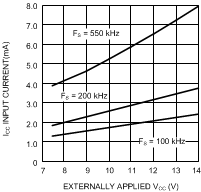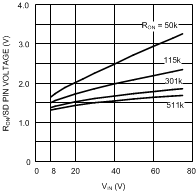SNVS307G September 2004 – April 2016 LM5010
PRODUCTION DATA.
- 1 Features
- 2 Applications
- 3 Description
- 4 Revision History
- 5 Pin Configuration and Functions
- 6 Specifications
- 7 Detailed Description
- 8 Application and Implementation
- 9 Power Supply Recommendations
- 10Layout
- 11Device and Documentation Support
- 12Mechanical, Packaging, and Orderable Information
Package Options
Mechanical Data (Package|Pins)
Thermal pad, mechanical data (Package|Pins)
- PWP|14
Orderable Information
6 Specifications
6.1 Absolute Maximum Ratings
over operating free-air temperature range (unless otherwise noted)(1)| MIN | MAX | UNIT | |
|---|---|---|---|
| VIN | 8 | 75 | V |
| VIN to GND | 76 | V | |
| BST to GND | 90 | V | |
| SW to GND (steady state) | –1.5 | V | |
| BST to VCC | 76 | V | |
| BST to SW | 14 | V | |
| VCC to GND | 14 | V | |
| SGND to RTN | –0.3 | 0.3 | V |
| SS to RTN | –0.3 | 4 | V |
| VIN to SW | 76 | V | |
| All other inputs to GND | –0.3 | 7 | V |
| Lead temperature (soldering, 4 s)(2) | 260 | °C | |
| Junction temperature, TJ | –40 | 150 | °C |
| Storage temperature, Tstg | –55 | 150 | °C |
(1) Stresses beyond those listed under Absolute Maximum Ratings may cause permanent damage to the device. These are stress ratings only, which do not imply functional operation of the device at these or any other conditions beyond those indicated under Recommended Operating Conditions. Exposure to absolute-maximum-rated conditions for extended periods may affect device reliability.
(2) For detailed information on soldering plastic HTSSOP and WSON packages, see Mechanical, Packaging, and Orderable Information.
6.2 ESD Ratings
| VALUE | UNIT | |||
|---|---|---|---|---|
| V(ESD) | Electrostatic discharge | Human-body model (HBM), per ANSI/ESDA/JEDEC JS-001(1) | ±2000 | V |
| Charged-device model (CDM), per JEDEC specification JESD22-C101(2) | ±750 | |||
(1) JEDEC document JEP155 states that 500-V HBM allows safe manufacturing with a standard ESD control process.
(2) JEDEC document JEP157 states that 250-V CDM allows safe manufacturing with a standard ESD control process.
6.3 Recommended Operating Conditions
over operating free-air temperature range (unless otherwise noted)| MIN | MAX | UNIT | ||
|---|---|---|---|---|
| VIN | Input voltage | 8 | 75 | V |
| IO | Output current | 1 | A | |
| Ext-VCC | External bias voltage | 8 | 13 | V |
| TJ | Operating junction temperature | –40 | 125 | °C |
6.4 Thermal Information
| THERMAL METRIC(1) | LM5010 | UNIT | ||
|---|---|---|---|---|
| DPR (WSON) | PWP (HTSSOP) | |||
| 10 PINS | 14 PINS | |||
| RθJA | Junction-to-ambient thermal resistance | 36 | 41.1 | °C/W |
| RθJC(top) | Junction-to-case (top) thermal resistance | 31.9 | 26.5 | °C/W |
| RθJB | Junction-to-board thermal resistance | 13.2 | 22.5 | °C/W |
| ψJT | Junction-to-top characterization parameter | 0.3 | 0.7 | °C/W |
| ψJB | Junction-to-board characterization parameter | 13.5 | 22.2 | °C/W |
| RθJC(bot) | Junction-to-case (bottom) thermal resistance | 3 | 3.3 | °C/W |
(1) For more information about traditional and new thermal metrics, see the Semiconductor and IC Package Thermal Metrics application report, SPRA953.
6.5 Electrical Characteristics
Typical values correspond to TJ = 25°C, minimum and maximum limits apply over TJ = –40°C to 125°C, VIN = 48 V, andRON = 200 kΩ (unless otherwise noted).(1)(2)
| PARAMETER | TEST CONDITIONS | MIN | TYP | MAX | UNIT | |
|---|---|---|---|---|---|---|
| VCC REGULATOR | ||||||
| VCCReg | VCC regulated output | 6.6 | 7 | 7.4 | V | |
| VIN - VCC | ICC = 0 mA, FS < 200 kHz, 7.5 V ≤ VIN ≤ 8 V |
1.3 | V | |||
| VCC output impedance (0 mA ≤ ICC ≤ 5 mA) | VIN = 8 V | 140 | Ω | |||
| VIN = 48 V | 2.5 | |||||
| VCC current limit | VCC = 0 V | 10 | mA | |||
| UVLOVCC | VCC undervoltage lockout threshold | VCC increasing | 5.8 | V | ||
| UVLOVCC hysteresis | VCC decreasing | 145 | mV | |||
| UVLOVCC filter delay | 100-mV overdrive | 3 | µs | |||
| IIN operating current | Non-switching, FB = 3 V | 650 | 850 | µA | ||
| IIN shutdown current | RON/SD = 0 V | 95 | 200 | µA | ||
| SOFT-START PIN | ||||||
| Pullup voltage | 2.5 | V | ||||
| Internal current source | 11.5 | µA | ||||
| CURRENT LIMIT | ||||||
| ILIM | Threshold | Current out of ISEN | 1 | 1.25 | 1.5 | A |
| Resistance from ISEN to SGND | 130 | mΩ | ||||
| Response time | 150 | ns | ||||
| RON/SD PIN | ||||||
| Shutdown threshold | Voltage at RON/SD rising | 0.35 | 0.65 | 1.1 | V | |
| Threshold hysteresis | Voltage at RON/SD falling | 40 | mV | |||
| HIGH-SIDE FET | ||||||
| RDS(ON) | Buck switch | ITEST = 200 mA | 0.35 | 0.8 | Ω | |
| UVLOGD | Gate drive UVLO | VBST - VSW Increasing | 3 | 4.3 | 5 | V |
| UVLOGD Hysteresis | 440 | mV | ||||
| REGULATION AND OVERVOLTAGE COMPARATORS (FB PIN) | ||||||
| VREF | FB regulation threshold | SS pin = steady state | 2.45 | 2.5 | 2.55 | V |
| FB overvoltage threshold | 2.9 | V | ||||
| FB bias current | 1 | nA | ||||
| THERMAL SHUTDOWN | ||||||
| TSD | Thermal shutdown temperature | 175 | °C | |||
| Thermal shutdown hysteresis | 20 | °C | ||||
(1) All minimum and maximum limits are specified by correlating the electrical characteristics to process and temperature variations and applying statistical process control.
(2) The junction temperature (TJ in °C) is calculated from the ambient temperature (TA in °C) and power dissipation (PD in Watts) as follows: TJ = TA + (PD × RθJA) where RθJA (in °C/W) is the package thermal impedance provided in Thermal Information.
6.6 Switching Characteristics
Typical values correspond to TJ = 25°C, minimum and maximum limits apply over TJ = –40°C to 125°C and VIN = 48 V (unless otherwise noted)(1)| PARAMETER | TEST CONDITIONS | MIN | TYP | MAX | UNIT | |
|---|---|---|---|---|---|---|
| RDS(ON) | Buck switch | ITEST = 200 mA | 0.35 | 0.8 | Ω | |
| UVLOGD | Gate drive UVLO | VBST - VSW Increasing | 3 | 4.3 | 5 | V |
| UVLOGD Hysteresis | 440 | mV | ||||
| OFF TIMER | ||||||
| tOFF | Minimum OFF-time | 265 | ns | |||
| ON TIMER | ||||||
| tON - 1 | ON-time | VIN = 10 V, RON = 200 kΩ | 2.1 | 2.75 | 3.4 | µs |
| tON - 2 | ON-time | VIN = 75 V, RON = 200 kΩ | 290 | 390 | 490 | ns |
(1) All minimum and maximum limits are specified by correlating the electrical characteristics to process and temperature variations while applying statistical process control.
6.7 Typical Characteristics
at TA = 25°C (unless otherwise noted) Figure 1. VCC vs VIN
Figure 1. VCC vs VIN
 Figure 3. ICC vs Externally Applied VCC
Figure 3. ICC vs Externally Applied VCC
 Figure 5. Voltage at RON/SD Pin
Figure 5. Voltage at RON/SD Pin
 Figure 7. Start-Up Sequence
Figure 7. Start-Up Sequence
 Figure 2. VCC vs ICC
Figure 2. VCC vs ICC
 Figure 4. ON-Time vs VIN and RON
Figure 4. ON-Time vs VIN and RON
 Figure 6. IIN vs VIN
Figure 6. IIN vs VIN